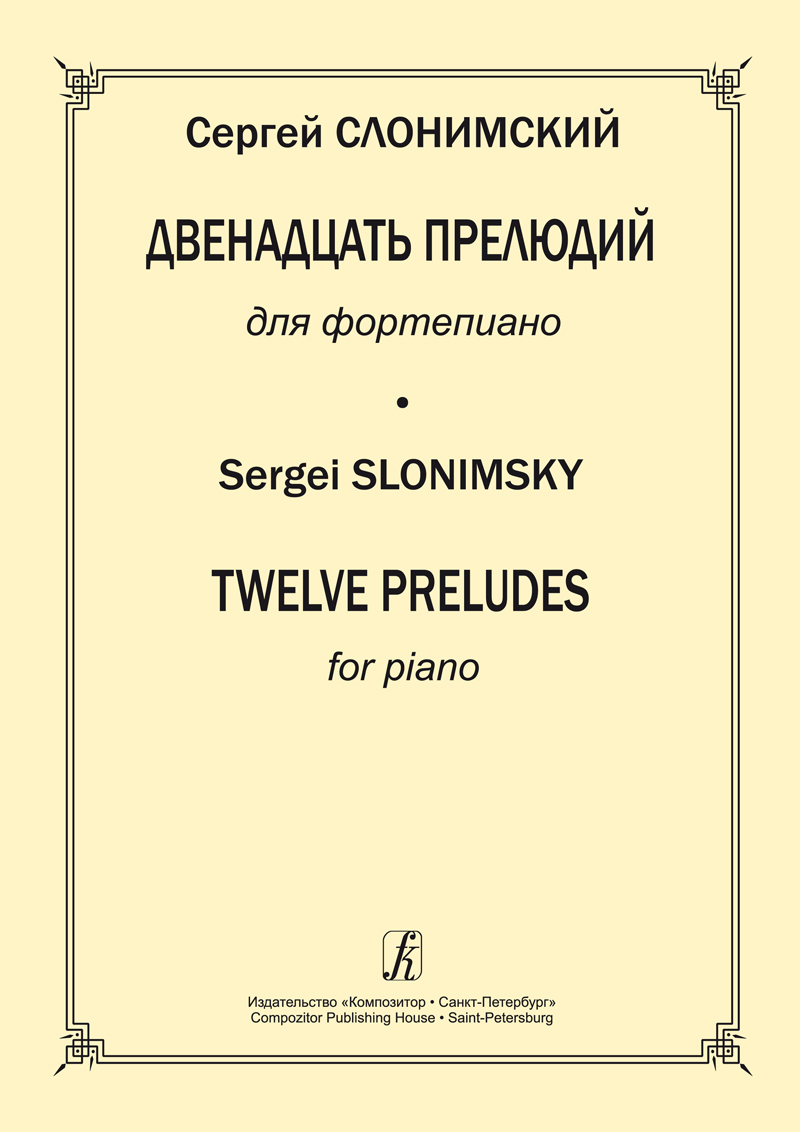
Slonimsky S. 12 Preludes for Piano
- Author:
- Slonimsky S.
- Author (full):
- Sergei Slonimsky
- Title (full):
- Twelve Preludes for Piano
- Number of pages:
- 32
Sergei Mikhailovich Slonimsky (born in 1932) is one of the leading modern Russian composers. His creation embraces actually all the genres. Remember the musical drama “Virineya” (1965–1967) after the novel by L. Seyfullina, chamber opera “Master and Margarite” (1970–1972) after M. Bulgakov, opera-ballad “Mary Stuart” (1978–1980) to Ya. Gordin’s libretto, dramma per musica “Hamlet” (1990–1991) after W. Shakespeare’s tragedy translated to Russian by B. Pasternak, chamber opera (monodic drama) “King Ixion” (1993–1995) after the ancient myth and the tragedy by I. Annensky, the Russian tragedy in 14 visions with three epilogues and overture “The Visions of Ioann Grozny” to Ya. Gordin’s libretto, dramma per musica “King Lear” (2000–2001) after the tragedy by W. Shakespeare translated by B. Pasternak, 32 symphonies, ballets, instrumental concertos, cantatas, among which there is the “Voice From Choir” (1962–1963) to the verses by Alexander Blok, “One Day of the Life” (1998) to the texts from “Chapter of the Thousand” by Dhammapada translated by V. Toporov, Requiem for soloists, choir and symphony orchestra (2003), so as numerous choral, chamber-instrumental and vocal compositions. The spring of 2005 was marked by the ballet premiиre of the “Magic Nut” after the tale by E. Th. A. Hoffmann to the libretto by the artist Mikhail Chemiakine, who staged it in the Mariinsky Theatre. It was in 2008, when Slonimsky’s oratorial opera “Antigone” after Sophokle’s tragedy was firstly staged by A. N. Sokurov at the St. Petersburg Academic Kapelle.
Sergei Slonimsky is the People’s Artist of Russia, laureate of the Russian State Prize, knight of the orders “Merits before Motherland” and of the Commander Cross of the Order “Merits before the Polish Republic”. Slonimsky’s opuses are on roll all over the world.
Among Slonimsky’s piano compositions there are two concertos for piano and orchestra: “Jewish Rhapsody” (Concerto № 1, 1997) and Concerto № 2 (2001), Sonata for piano (1961), cycle of 24 Preludes and Fugues (1994).
Slonimsky composed cycles for children and youth “From Five to Fifty” (the first two volumes consist of pieces for two hands, the fourth and fifth volumes contain piano duets), “Three Forest Stories”, “Virtual Reality”, “Africa”, “From the Russian Folk Tales”, “Green Years”, “First Steps on the Keyboard”, “Child’s Summer Day” and “Musical Journey Over Lands and Continents”.
Twelve Preludes by Sergei Slonimsky resemble some bridge between the music world of grown-ups and children’s emotional sphere.
As for the tonal structure, it’s far from traditional ones. Usually the cycles of 24 preludes and fugues in all tonalities are disposed two ways: either by pairs of keys of the same name, ascending along the chromatic scale ( e. g. J. S. Bach’s “Well-Tempered Clavier”), or parallel tonalities distributed along the circle of fourths and fifths (e. g. Chopin and Shostakovich). Slonimsky determines neither major, nor minor — only the central tone is acclaimed. Thus instead of 24 pieces, there are 12 ones. Remember Hindemith’s “Ludus tonalis” — 12 Fugues with the interludes between them. Slonimsky’s Preludes are set on the keys of descending chromatic scale, i. e. C, B, B flat, and so on down to C sharp.
The same emotional conception — from light to darkness, tragedy — is this cycle. Contemplative penultimate piece, composed in sonorous technique, bursts out in impetuous finale. Descending passacaglia basso concludes the whole elaboration of the cycle.
Alexander Kharkovsky
- Author
- Slonimsky S.
- Author (full)
- Sergei Slonimsky
- Title (full)
- Twelve Preludes for Piano
- Number of pages
- 32

